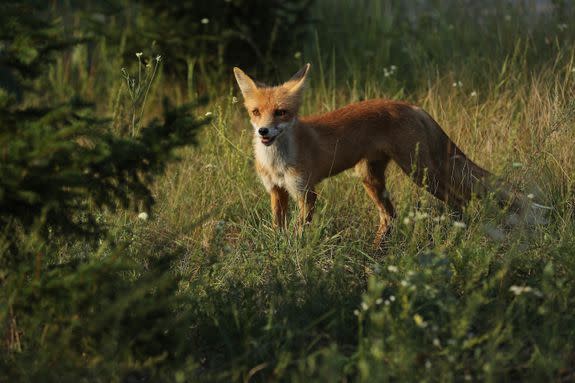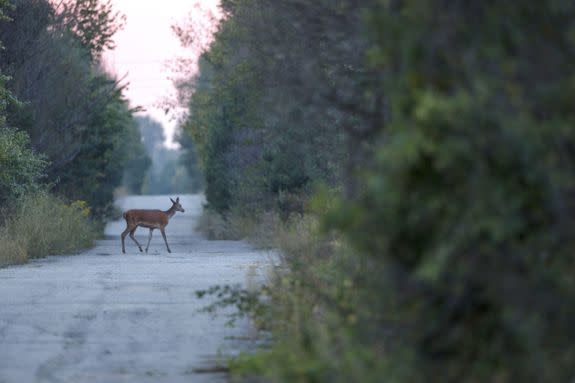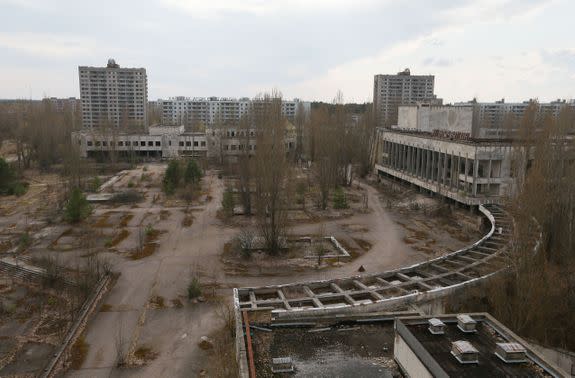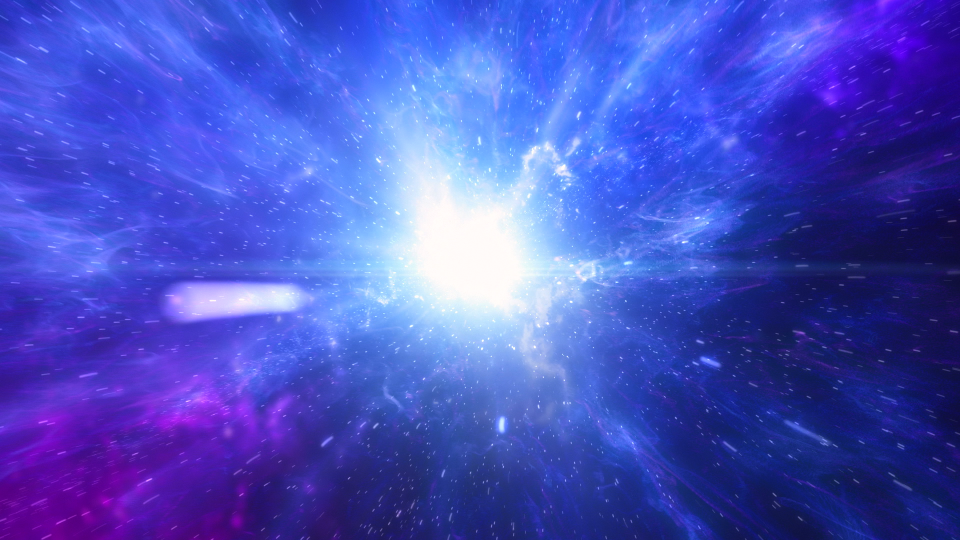A wolf left its irradiated Chernobyl home. What happens if it mates?

In the winter of 2015, a young male wolf left its home in the radiation-contaminated zone around Chernobyl, a Soviet nuclear plant that catastrophically exploded and melted down in 1986. The wolf traveled over 200 miles from its irradiated home, ranging into uncontaminated woods and, perhaps, meeting other wolves.
The travels of this lone wolf are only known because scientists fitted it with a GPS tracking device to follow its movements. Their research, published last month in the European Journal of Wildlife, begs questions about whether the wolves of Chernobyl might be mating with and passing along any mutated genes to other gray wolf populations, leading to wolves with marred genomes, reproductive problems, or whatever else might come of mutation.
But to begin with, it's exceedingly unlikely that the radiation outside the ruined Chernobyl reactor — the worst of which long dissipated — has changed the wolves in meaningful ways. It's possible, though, that some subtler mutations have occurred, and may have spread by wolves journeying well outside the long-abandoned Chernobyl Exclusion Zone (CEZ).
SEE ALSO: The matriarch of the Alaska bear cam makes her glorious return to the river
"It’s not impossible that a genetic mutation can be passed down — but we don’t have enough data to say it’s happening,” Michael Byrne, a wildlife ecologist at the University of Missouri who led the research, said in an interview.
Whatever radiation the wolves here have experienced, it hasn't appeared to produce harmful changes — if any — to their bodies. In fact, these wolf populations are thriving.
"Wolf populations have done pretty well since the accident," James Smith, an environmental scientist who researches the effects of radiation on wildlife around Chernobyl, said in an interview.
The wolf numbers in the Chernobyl Exclusion Zone are around seven times higher than in wildlife refuges outside the zone, said Smith, who had no involvement in the wolf-tracking study. Even in "hotspots" with more radiation, mammals haven't been hit with any observable population declines. Previously, Smith compared mammal abundance in areas of higher radiation with those of lower radiation.
"We couldn't see any differences," said Smith.

Image: Sean Gallup/Getty Images
And even if there are actual physical manifestations of mutation in these wolves, they're almost certainly subtle — not dramatic changes like, say, a second tail.
"The popular definition of a mutant is a bit different than the scientific definition," said Smith. "In the popular mind, 'mutant' conjures up two-headed wolves with glowing hair — but the scientific definition is any change in genes."
The wolf populations don't appear to have changed much, and their flourishing populations have been further helped along by the reality that this contaminated zone is now a bustling nature reserve.
"It’s basically a wildlife refuge," said Byrne. "If you just walk around, you see lots of wildlife."
The wildlife here has flourished since humans abandoned the area, including the entire city of Pripyat, home to nearly 50,000 people before the meltdown.
"The radiation probably has subtle effects in hot spots, but it doesn’t compare to the ordinary damage people do to environments," said Smith, citing deforestation, pollution, and habitat razed for agriculture.

Image: Luke Massey/Solent News/REX/Shutterstock
These vibrant populations mean more Chernobyl wolves, who sometimes get pushed out of the pack or simply want to set out on their own, will seek new territory and new lives outside the infamous area.
"The young wolves, even when they’re kicked out of the house, can travel really long distances," said Byrne. "It's not necessarily shocking that it made this journey."
But what if a wolf with mutated genes did mate with a wolf outside of Chernobyl?
Although there's not evidence of this occurring, it very well could have already happened, many times. There may only be this single GPS-documented case of a wolf ranging far from its Chernobyl home, yet in surrounding Ukraine and Belarus "it's pretty well known that this has been happening for a pretty long time," said Smith.
But even if mating between the two wolf populations did occur and a mutated gene was passed along, it wouldn't necessarily lead to a negative or horrible outcome, like an impaired ability to reproduce or blindness.
"Not all mutations are bad," Bridgett vonHoldt, an evolutionary biologist at Princeton University who researches wolf genetics, said over email.
"Mutations are the bread and butter of diversity, and can enhance proteins, or gene expression patterns, etc.," she said. But, she notes, "They can also be harmful."

Image: SERGEY DOLZHENKO/EPA/REX/Shutterstock
Even if the Chernobyl wolves carried harmful genes — which it appears they aren't — there's no guarantee the genes would be passed to their offspring.
Mutations are generally caused by recessive genes, said vonHoldt, which means that an offspring must have two copies of a mutated gene for there to be an actual phenotypical, or physical, effect, she said. And this would only occur, vonHoldt underscores, if the genes were "functionally linked."
In short, if one wolf has a mutated gene that affects eyesight, and another wolf has a mutated gene that affects reproduction, the mutations would likely be irrelevant to offspring. So, when a wolf with mutations mates with a wolf with no mutations, "most radiation-caused mutations" won't be expressed on or in the body, said vonHoldt.
However, wolves in the contaminated zone are doing lots of mating. Accordingly, if a mutation — beneficial or harmful — is passed down to different offspring, conventional genetics show that it's possible for wolf offspring to acquire two copies of a recessive genetic mutation, which would then manifest as a physical change.
Just being in this zone may also force the creatures here to adapt to the irradiated environment, in an attempt to avoid potentially harmful mutations. In 2014, researchers found that some birds in the zone are now producing more antioxidants, chemicals that fight the cellular damage inflicted by radiation.
Any bird, fox, or wolf here that does end up mutating, however, would still have much in common with all life on Earth — including us.
"Genetic change is going on all the time — that’s what evolution is," said Smith.
"In a sense, we're all mutants."
WATCH: Ever wonder how the universe might end?


